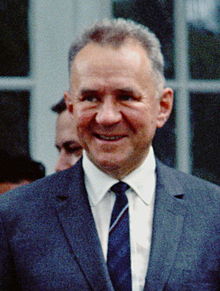Aleksei Kosygin
| Alexei Kosygin Алексей Косыгин |
|
|---|---|

Kosygin at the Glassboro Summit Conference, 23 June 1967
|
|
| Chairman of the Council of Ministers | |
|
In office 15 October 1964 – 23 October 1980 |
|
| Deputy | |
| Preceded by | Nikita Khrushchev |
| Succeeded by | Nikolai Tikhonov |
| First Deputy chairman of the Council of Ministers | |
|
In office 4 May 1960 – 15 October 1964 |
|
| Premier | Nikita Khrushchev |
| Preceded by | Frol Kozlov |
| Succeeded by | Dmitriy Ustinov |
| Chairman of the State Planning Committee | |
|
In office 20 March 1959 – 4 May 1960 |
|
| Premier | Nikita Khrushchev |
| Preceded by | Joseph Kuzmin |
| Succeeded by | Vladimir Novikov |
| Chairman of the Council of People's Commissars of the Russian SFSR | |
|
In office 23 June 1943 – 23 March 1946 |
|
| Premier | Joseph Stalin |
| Preceded by | Ivan Khokhlov |
| Succeeded by | Mikhail Rodionov |
| Full member of the 18th, 22nd, 23rd, 24th, 25th Politburo | |
|
In office 4 May 1960 – 21 October 1980 |
|
|
In office 4 September 1948 – 16 October 1952 |
|
| Candidate member of the 18th, 19th, 20th Politburo | |
|
In office 29 June 1957 – 4 May 1960 |
|
|
In office 16 October 1952 – 5 March 1953 |
|
|
In office 18 March 1946 – 4 September 1948 |
|
| Personal details | |
| Born |
Alexei Nikolayevich Kosygin 21 February [O.S. 8 February] 1904 St. Petersburg, Russian Empire |
| Died | 18 December 1980 (aged 76) Moscow, Russian SFSR, Soviet Union |
| Citizenship | Soviet |
| Nationality | Russian |
| Political party | Communist Party of the Soviet Union |
| Spouse(s) | Klavdia Andreyevna (died 1967) |
| Residence | House on the Embankment |
| Profession | Teacher, civil servant |
| Military service | |
| Allegiance | Russian SFSR |
| Service/branch | Red Army |
| Years of service | 1919–1921 |
| Rank | Conscript |
| Commands | Red Army |
| Battles/wars | Russian Civil War |
Alexei Nikolayevich Kosygin (Russian: Алексе́й Никола́евич Косы́гин, tr. Aleksej Nikolajevič Kosygin; IPA: [ɐlʲɪˈksʲej nʲɪkɐˈlajɪvʲɪtɕ kɐˈsɨɡʲɪn]; 21 February [O.S. 8 February] 1904 – 18 December 1980) was a Soviet-Russian statesman during the Cold War. Kosygin was born in the city of Saint Petersburg in 1904 to a Russian working-class family. He was conscripted into the labour army during the Russian Civil War, and after the Red Army's demobilisation in 1921, he worked in Siberia as an industrial manager. Kosygin returned to Leningrad in the early 1930s and worked his way up the Soviet hierarchy. During the Great Patriotic War (World War II), Kosygin was a member of the State Defence Committee and was tasked with moving Soviet industry out of territories soon to be overrun by the German Army. He served as Minister of Finance for a year before becoming Minister of Light Industry and later, the Minister of Light and Food Industry. Stalin removed Kosygin from the Politburo one year before his own death in 1953, intentionally weakening Kosygin's position within the Soviet hierarchy.
After the power struggle triggered by Stalin's death in 1953, Nikita Khrushchev became the new leader. On 20 March 1959, Kosygin was appointed to the position of Chairman of the State Planning Committee (Gosplan), a post he would hold for little more than a year. Kosygin next became First Deputy chairman of the Council of Ministers. When Khrushchev was replaced in 1964, Kosygin and Leonid Brezhnev became Premier and First Secretary respectively. Kosygin, along with Brezhnev and Nikolai Podgorny, the Chairman of the Presidium of the Supreme Soviet, was a member of the newly established collective leadership. Kosygin became one of two major power players within the Soviet hierarchy, the other being Brezhnev, and was able to initiate the failed 1965 economic reform, usually referred to simply as the Kosygin reform. This reform, along with his more open stance on solving the Prague Spring (1968), made Kosygin one of the most liberal members of the top leadership.
...
Wikipedia
